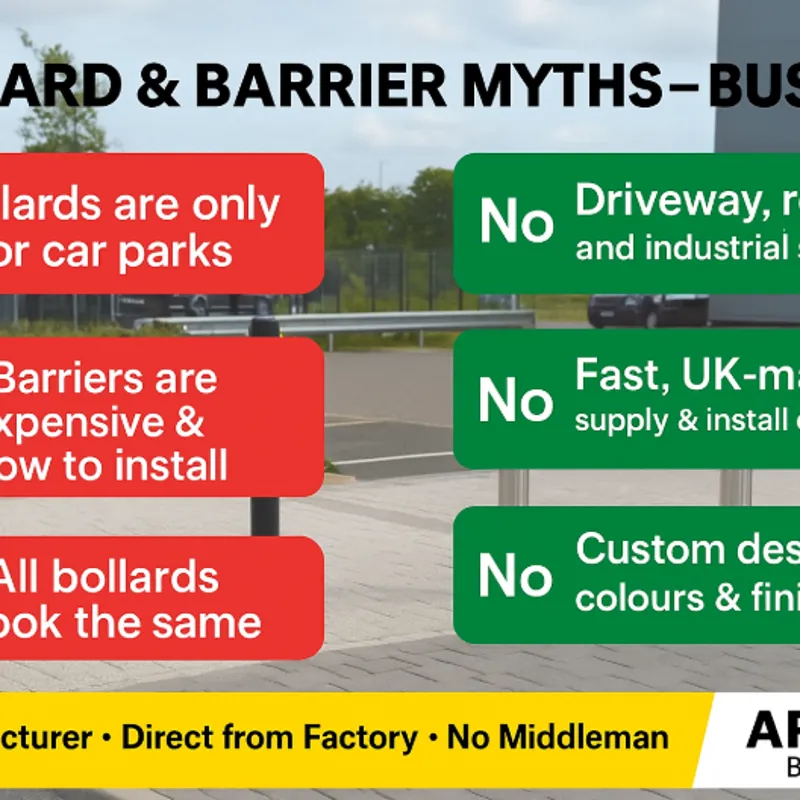🚧 Debunking Common Myths About Bollards and Barriers
When it comes to enhancing safety and security, bollards and barriers are essential tools. However, several misconceptions surrounding these protective measures can lead to confusion. Let's set the record straight by debunking some common myths, helping you make informed decisions about your security needs.
💸 Myth 1: Bollards Are Expensive and Not Worth the Investment
While the initial cost of installing bollards might seem high, it’s important to view them as a long-term investment. With proper maintenance, bollards can last anywhere from 10 to 30 years, ensuring significant value over time. Their durability and low maintenance make them a smart investment, as the cost per year significantly reduces over their service life.
🔑 The Truth: Bollards Are Built to Last
- Bollards are made from high-quality materials such as steel and stainless steel, which can withstand harsh weather conditions and impacts.
- Their longevity means you won’t need to replace them frequently, saving money in the long run.
🔒 Myth 2: Removable Bollards Compromise Security
Many people believe that removable bollards are less secure than fixed bollards. However, this isn’t true. Modern removable bollards are crafted from robust materials, such as steel, and are designed to meet high-security standards. They undergo rigorous testing to withstand significant impacts and feature various locking mechanisms to ensure they remain securely in place when installed.
🔑 The Truth: Removable Bollards Can Be Highly Secure
- Removable bollards offer flexibility while maintaining high security.
- They are perfect for areas that require both high security and the ability to move or adjust the barriers when needed.
🔨 Myth 3: Bollards Are Difficult to Install
With recent advancements in bollard design, installation has become quick and efficient. Many bollards now feature quick-release mechanisms and modular designs, allowing for easy integration into existing infrastructure with minimal tools and expertise. This reduces downtime, labor costs, and disruption, making the installation process much smoother.
🔑 The Truth: Bollards Are Easy to Install
- Installation is faster and less intrusive than ever.
- Many bollard solutions are designed to integrate seamlessly with minimal disruption to existing spaces.
🚶♂️ Myth 4: Barriers Are Only for High-Risk Areas
While barriers are crucial in high-risk areas like construction sites or military zones, they are also beneficial in everyday settings. Barriers help manage traffic flow, protect pedestrians, and prevent unauthorised access—all contributing to safety in various environments.
🔑 The Truth: Barriers Are Versatile and Necessary
- Barriers can be used in schools, shopping centers, public spaces, and residential areas.
- They offer protection in both low-risk and high-risk environments, ensuring safety for people and property.
🚫 Myth 5: Bollards and Barriers Are the Same
Bollards and barriers are not the same. While both provide safety and security, they serve different purposes.
🔑 The Truth: Bollards and Barriers Have Different Functions
- Bollards: Short, sturdy posts that control traffic flow, prevent collisions, and protect pedestrians, buildings, and other structures. They allow free pedestrian flow while restricting vehicle access.
- Barriers: Typically used to block vehicle access to restricted areas entirely. Barriers are larger structures that prevent entry.
Choosing the right measure depends on the specific needs of your location.
💪 Myth 6: Barriers Are Only as Strong as Their Strongest Point
One common misconception is that a barrier’s strength is determined by its strongest point. In reality, a safety barrier is only as strong as its weakest point. This means that the entire structure must be robust and well-maintained to ensure maximum effectiveness.
🔑 The Truth: The Entire Structure Must Be Strong
- A well-designed barrier needs to be uniformly strong across the entire structure.
- Regular maintenance is key to keeping barriers effective and reliable.
🤔 Myth 7: Flexible Bollards Provide the Same Protection as Rigid Ones
Flexible bollards are designed to bend upon impact, making them suitable for low-speed areas. However, they are generally not suitable for high-security zones. They typically can't withstand direct impacts from vehicles, so they are not as effective in restricting vehicle access.
🔑 The Truth: Rigid Bollards Offer Greater Protection
- Rigid bollards are ideal for high-security environments, where vehicles may pose a serious threat.
- Flexible bollards are better suited for environments where traffic speeds are low, but not for high-security applications.
🎯 Conclusion: Understanding Bollards and Barriers for Better Security
Understanding the facts about bollards and barriers is crucial for making informed decisions about your safety measures. By debunking these myths, we can better appreciate the true value and functionality of these essential tools in protecting people, property, and assets.
Whether you need a bollard, a barrier, or a combination of both, the right choice will depend on your specific needs and the environment in question. Take the time to explore the options available and ensure your property is equipped with the best security solutions.

